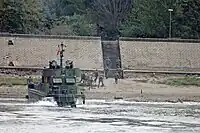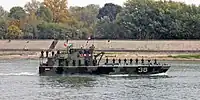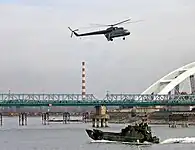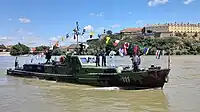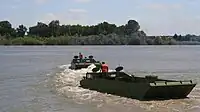| River Flotilla | |
|---|---|
| Речна флотила | |
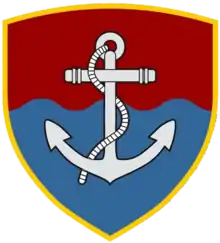 Emblem of the Serbian River Flotilla | |
| Founded | 1915 (current form since 2006) |
| Country | |
| Branch | |
| Type | Brown-water navy |
| Role | Control of inland waterways |
| Size | ~500 personnel 29 ships and boats |
| Part of | |
| Headquarters | Novi Sad |
| Motto(s) | For Freedom and Honour of the Fatherland (Za slobodu i čast Otadžbine) |
| Anniversaries | 19 August[1] |
| Engagements | First Balkan War Second Balkan War World War I World War II Yugoslav Wars |
| Commanders | |
| River Flotilla Commander | Captain Ljubiša Marković |
| Insignia | |
| Flag | 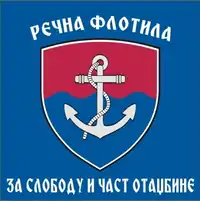 |
| Ensign |  |
The Serbian River Flotilla (Serbian: Речна флотила, romanized: Rečna flotila) is a tactical brigade-level brown water naval branch subordinated to the Serbian Army of the Serbian Armed Forces. Patroling on the Danube, Sava, and Tisa rivers, it is tasked with environmental policing, counter-terrorism, and border security along country's international river borders.
History
The modern Serbian River Flotilla pulls it origins from Serbian Šajkaši river troops that guarded the Danube and Sava rivers, and especially, the Port of Belgrade, against Ottoman Empire river fleets from the 16th to the 19th century. Led by Hungarian or Austrian sponsors against the Ottomans, šajkaš troops were ethnic Serbs, who enjoyed special military status. Their name Šajkaš was derived from the small wooden boat known as chaika (Šajka, tschaiken), a type of galley operated by sail or oars manned by 30 and 50 men, commanded by an officer, a helmsman, an armourer, a drummer, two bowman, and up to 36 oarsmen. The modern day traditional Serbian šajkača hat is believed to be derived from the 18th-century Banat based Frontier Šajkaši Battalion uniform.[2]
The Šajkaši played a decisive role in helping Serbia become an independent constitutional monarchy and lay the ground for the creation of modern Serbia.[3] After the declaration of the war against Ottoman Empire in 1876, the Principality of Serbia River Flotilla deployed naval mines on the Danube, thought to be the first use of naval mines in Europe.[3]
The Kingdom of Serbia received its first true warship, the patrol boat "Jadar", on August 19 (O.S. August 6), 1915 and that date is commemorated as the establishment of the modern Serbian River Flotilla.[4] During the World War I flotilla protected lines of communication between Belgrade and Obrenovac, assisted in the transport of Serbian troops in Syrmia, mined waterways and performed reconnaissance.
As an allied victor in 1918, Serbia began the reconstruction and reconstitution of its armed forces, in a new state of the Kingdom of Yugoslavia. Within the Naval Department, the Danube Flotilla was headquartered in Novi Sad and commanded over the naval detachments on rivers and lakes. The fleet included the monitors' group, a number of auxiliary vessels, a proper naval base and a detachment of ships on Lake Ohrid in Macedonia.
During Yugoslav states it was organized in detachments of armored river boats, river assault ships, river auxiliary ships and minesweepers within the Yugoslav Navy.
The Yugoslav River Flotilla took an active part in War in Croatia in 1991, conducting patrol and combat missions on Danube, particularly during the Battle of Vukovar.
Following the breakup of Yugoslavia, the Yugoslav People's Army became the Armed Forces of Serbia and Montenegro in 1992 and during that transition the River Flotilla remained part of Navy. During the 1990s, one new Neštin class river minesweeper was introduced in 1999, and two 601 class landing craft were transferred from sea service at Montenegro to the River Flotilla after being overhauled at "Brodotehnika Shipyard" in Belgrade. The Flotilla in its current form was formed on October 2 2008 when pontoon units were added to the Flotilla's structure. In 2017, the flagship command ship "Kozara" sailed from Novi Sad to Hungary in the first international voyage of a Serbian military ship since 1915.[5][6]
Missions
Tactical doctrine and operating procedures of the Serbian River Flotilla remain the same as those of the former Danube Flotilla of the Royal Yugoslav Navy.
The primary missions include:[7]
- building and maintaining operational capabilities for carrying out tasks of all three missions of the Serbian Armed Forces,
- operationalization and training of command and subordinate units for carrying out dedicated tasks,
- control of inland waterways and provision of maneuvers to the units of the Serbian Army on and to rivers, channels and lakes
- search and rescue on rivers, canals and lakes.

Largest and most complex to date search and rescue operation was during the 2014 floods in Serbia, when members of the 1st Pontoon Battalion helped fight flood in Šabac and Loznica while amphibious vehicles and divers from 93rd Diving Company evacuated 2,072 people from Obrenovac.[8] Members of the River Flotilla were deployed throughout the country (Koceljeva, Šabac, Lazarevac, Lajkovac, Lučani and Loznica) to combat flooding: mainly in the evacuation of citizens and the reinforcement of bulwarks.[9]
Since 2011, personnel from the River Flotilla have been deployed to Operation Atalanta, an ongoing European Union multinational counter-piracy operation off the Horn of Africa and in the Western Indian Ocean. Deploying as the Serbian Autonomous Vessel Protection Detachment (AVPD), where River Flotilla personnel are directly stationed on World Food Programme (WFP) ships in need of protection.[10]
Structure
.jpg.webp)
The River Flotilla is subordinated to the Serbian Army as the landlocked Serbian military doesn't possess naval branch. It is headquartered in Novi Sad, with additional units based in Belgrade and Šabac.
- Command Company (Novi Sad)
- 1st River Detachment (Novi Sad)
- 93rd Diving Company [11]
- 2nd River Detachment (Belgrade)
- 1st Pontoon Battalion (Šabac)
- 2nd Pontoon Battalion (Novi Sad)
- Logistics Company (Novi Sad)
Equipment
The River Flotilla's surface fleet mostly date from the 1970s, but since being well maintained and subjected to periodic modest upgrades are considered to be adequate for at least another decade. Five Neštin class river minesweepers constitute the core of the fleet and although minesweepers their primary role is that of universal vessels for the control of river ways. They are expected to be in service until the end of 2020s as are Type 22 landing crafts and Type 20 patrol boats. To supplement these vessels, the flotilla has procured a number of small civilian craft, including one Premax 39 multirole fast combat boat built domestically by Yugoimport SDPR.[12]
In October 2013, a four-year general overhaul and modification of the flotilla's flagship ship, BPN-30 "Kozara”, was completed at "Apatin Shipyard" with the addition of new diesel-electric propulsion, giving the River Flotilla functional capabilities of a hospital ship as well as navigation and shipping training ship for cadets attending the Serbian Military Academy.[13] In 2017, China donated 24 RIB-720 boats equipped with 150 hp Yamaha outboard motors to the Serbian Armed Forces, of which 10 boats were allocated to the River Flotilla.[14]
Surface Fleet
| Current Surface Fleet | |||||
|---|---|---|---|---|---|
| Ships | Origin | Class | Type | Ships in service | Notes |
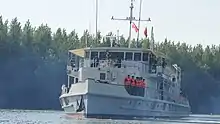 BPN-30 "Kozara" |
BPN-30 "Kozara" | Command ship Special purpose ship |
BPN-30 "Kozara" | BPN-30 "Kozara" command ship
(БПН - Брод посебне намене; BPN - Brod posebne namene)
| |
 RML-336 "Smederevo" |
Neštin class | River minesweeper | RML-332 "Titel"
RML-335 "Apatin" RML-336 "Smederevo" RML-341 "Novi Sad" |
Neštin class river minesweeper
(РМЛ - Речни миноловац; RML - Rečni minolovac)
| |
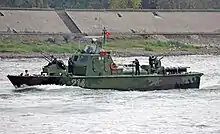 RPČ-214 "Morava" |
Type 20 Biscaya class | River patrol craft | RPČ-213 "Kolubara"
RPČ-214 "Morava" RPČ-216 "Timok" |
Type 20 Biscaya class river patrol craft
(РПБ - Речни патролни брод; RPB - Rečni patrolni brod)
| |
 RPČ-111 "Jadar" |
No class | River patrol craft | RPČ-111 "Jadar" | River patrol craft 111 "Jadar"
(РПЧ - речни патролни чамац; RPČ - rečni patrolni čamac) River patrol boat of the Serbian River Flotilla, armed with twin M71 20 mm anti-aircraft guns. The ships were built in Regensburg in 1953 for the United States Rhine River Patrol later transferred to the Yugoslav Navy's river flotilla. Today it serves mostly in a ceremonial role as the flagship of the flotilla. | |
 DB-411 "Bečej" |
Type 22 441 class | Landing craft | DB-411 "Bečej"
DB-412 "Belegiš" DB-413 "Taraš" DB-414 "Begeč" DB-415 "Šajkaš" |
Type 22 441 class landing craft
(ДБ - Десантни брод; DB - Desantni brod)
| |
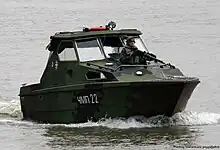 ČMP-22 |
No class | River patrol boat | ČMP-22
ČMP-23 ČMP-24 |
River patrol boat
(ЧМП - Чамац моторни патролни; ČMP - Čamac motorni patrolni)
| |
| No class | Multirole fast combat boat | "Premax 39" | Multirole fast combat boat
(Вишенаменски брзи борбени чамац; Višenamenski brzi borbeni čamac)
| ||
 RIB 720 |
RIB 720 | Rigid hull inflatable boat | 10 | RIB 720 rigid inflatable boat
(Неборбени чамац; Neborbeni čamac)
| |
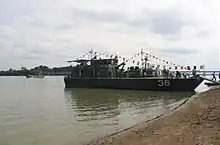 PRB-36 "Šabac" |
RSRB-36 "Šabac" | Degaussing vessel | PRB-36 "Šabac" | PRB-36 Šabac degaussing vessel
(ПРБ - Помоћни речни брод; PRB - Pomoćni rečni brod)
| |
| RPN-43 | Replenishment tanker | RPN-43 | RPN-43 replenishment tanker
(РПН - Речна пениша нафте; RPN - Rečna peniša nafte)
| ||
Engineering Vehicles
| Engineering vehicles | ||||
|---|---|---|---|---|
| Vehicles | Origin | Name | Type | Quantity |
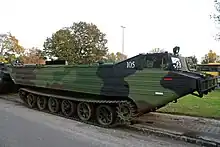 |
PTS-M | Amphibious transport vehicle | 12 | |
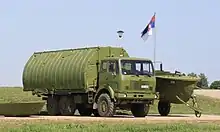 |
PM M71 | Mobile pontoon bridge | ||
 |
RPR M68 | Bridging boat | ||
Training
.jpg.webp)
Members of the River Flotilla are educated and trained at the Nautical Department of the Serbian Military Academy which offers courses in Serbian and English for domestic and international military and civilian students. Boat crews are trained to operate vessels for day and night operations in accordance with national standards and International Maritime Organization safety standards. The River Flotilla primarily conducts training for boat safety, navigation, night vision, communications, operator maintenance, high‐speed maneuvering, handling weapons (including crew‐served weapons) and other individual and collective skills unique to riverine craft operating in a riverine environment.[15]
Exercises
The River Flotilla regularly conducts live-fire and manoeuvre exercises with both domestic and international military, public safety and riverine forces including, Croatia, Hungary, Bulgaria, and Romania. Exercises generally involve anti-terrorism and disaster relief scenarios and often include live firing against land and water targets.[16][17][18][19][20][21][22][23]
Multinational exercises
Since 2011, the Serbian River Flotilla and the Hungarian Danube Flotilla, have jointly conducted the week-long exercise series dubbed "Iron Cat", alternating locations every year. The aim of the exercise series is to enhance bilateral cooperation and improve the application of tactics, techniques and procedures of both river units while building mutual trust. Both the Serbians and the Hungarians operate the Neštin class river minesweepers.
Iron Cat 2019 - held in Serbia at the training ground "Titel" and focused on the protection of river traffic, including mine detection, deactivating and destroying underwater mines, anti-ship actions and anti-terrorism actions.[24][25]
Iron Cat 2018 - held between Budapest and Mohács, Hungary included training in explosive ordnance disposal, river policing, border surveillance and border control, patrol activities, arresting and occupying hostile vessels, escorting and protecting dignitaries and cargo, and river closures. Serbian and Hungarian vessels also conducted live-fire training against air and water targets.[26][27]
Iron Cat 2017 - held near Banoštor, Serbia included training in the blockade and control of inland waterways due to migratory and terrorist threats in the region.[28][29]
Iron Cat 2016 - held in Budapest, Hungary included training in protection of cargo ships from attack, securing and blockade of the river.[30][31]
Iron Cat 2015 - tactival live fire exercise held at the Serbian artillery training ground "Titel" on the Tisa River.[32][33]
Iron Cat 2014 - tactical live fire exercise held at the Hungarian Defence Forces Várpalota range in Hungary included joint minesweeping activities.[34]
Iron Cat 2013 - tactical live fire exercise at the Serbian artillery training ground "Titel" on the Tisa River.[35]
Iron Cat 2012 - tactical live fire exercise at the Hungarian Defence Forces Várpalota range included shooting ground-based targets on the using the 20mm PAV-1 and PAV-4 autocannons.[32]
Iron Cat 2011 - tactical life fire exercise at the Serbian artillery training ground "Titel" on the Tisa River in Serbia South Bačka District, Serbia.[32][33]
International Army Games 2016 - 86 members of 1st and 2nd Pontoon battalions and 93rd Diving Company won third place at Russian International Army Games during the "Open water" competition held in Murom, on the Oka River.[36][37]
Domestic exercises
Begej 2019 - Live Fire Tactical Training (LFTT) exercise held on the Tisa River at the training ground "Titel" including river and special assault, ship fire support, establishment of a bridge crossing point, as well as aircraft strikes.[38]
Blue Route 2019 - Live Fire Tactical Training (LFTT) exercise held on the Tisa River at the Titel training ground conducting a twentyfour-hour check of readiness of the Quick Reaction Naval Combat Group composed of a command ship and three ships of different types.[39]
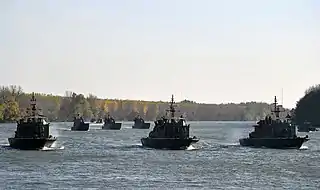
Century of Victory 1918-2018 - joint River Flotilla and the then-Special Brigade exercise in 100th anniversary of the end of the World War I. The exercise involved the display of anti-sabotage effects of submersible divers, the action of a group of ships and patrol boats, amphibious and multi-purpose ships in the firing of combat.[40]
Otter 2018 - Live Fire Tactical Training (LFTT) exercise held at training ground "Taraš" near Zrenjanin training River Flotilla command and units and pontoon battalions in the conduct of river assaults, defending waterways and forced river crossings.[41]
Ečka 2017 - anti-terrorist and anti-mining exercise of the 1st River Detachment and 93rd Diving Company at the training ground "Titel" on the Tisa River.[42]
Blue Dolphin 2016 - Live Fire Tactical Training (LFTT) exercise at the training ground "Taraš" on the Tisa River near Zrenjanin as part of "Morava 2016" command-post exercise.[43][44]
Blue Response 2014 - tactical live shooting exercise at the Serbian artillery training ground "Titel" on the Tisa River included artillery and close air support training in support of a forced river crossing.[45]
Tisa 2012 - three-day trilateral exercise including Serbia, Romania and Hungary held at training ground "Mačvanski partizanski odred" near Šabac, Serbia included training in assisting civilian populations affected by the floods caused by the outflow of the Sava river.[46]
Traditions
Anniversary
The anniversary of the unit is celebrated on August 19. On that date (O.S. August 6)in 1915 Kingdom of Serbia received its first true warship, the patrol boat "Jadar", on August 19 (O.S. August 6), 1915 and that date is commemorated as the establishment of the modern River Flotilla.
Patron saint
The unit's slava or its patron saint is Saint Stefan Štiljanović.[47]
Ranks
Officers
Rank insignia for commissioned officers.
| Rank group | General / flag officers | Senior officers | Junior officers | Officer cadet | ||||||||||||||||||||||||||||||||
|---|---|---|---|---|---|---|---|---|---|---|---|---|---|---|---|---|---|---|---|---|---|---|---|---|---|---|---|---|---|---|---|---|---|---|---|---|
 -O12.svg.png.webp) |
 -O11.svg.png.webp) |
 -O10.svg.png.webp) |
 -O9.svg.png.webp) |
-O7.svg.png.webp) |
 |
-O5.svg.png.webp) |
-O4.svg.png.webp) |
-O3.svg.png.webp) |
-O2.svg.png.webp) |
-O1.svg.png.webp) |
||||||||||||||||||||||||||
| Адмирал Admiral |
Вицеадмирал Vitseadmiral |
Контраадмирал Kontraadmiral |
Комодор Komodor |
Капетан бојног брода Kapetan bojnog broda |
Капетан фрегате Kapetan fregate |
Капетан корвете Kapetan korvete |
Поручник бојног брода Poručnik bojnog broda |
Поручник фрегате Poručnik fregate |
Поручник корвете Poručnik korvete |
Потпоручник Potporučnik |
||||||||||||||||||||||||||
Enlisted
The rank insignia of non-commissioned officers and enlisted personnel.
| Rank group | Senior NCOs | Junior NCOs | Enlisted | |||||||||||||||||||||||||||||||||
|---|---|---|---|---|---|---|---|---|---|---|---|---|---|---|---|---|---|---|---|---|---|---|---|---|---|---|---|---|---|---|---|---|---|---|---|---|
 |
 |
 |
 |
 |
 |
 |
 |
No insignia | ||||||||||||||||||||||||||||
| Заставник I класе Zastavnik I klase |
Заставник Zastavnik |
Старији Водник I класе Stariji Vodnik I klase |
Старији Водник Stariji Vodnik |
Водник Vodnik |
Млађи водник Mlađi vodnik |
Десетар Desetar |
Разводник Razvodnik |
Војник Vojnik | ||||||||||||||||||||||||||||
Gallery
See also
References
- ↑ https://www.vs.rs/en/about-saf/tradition/military-holidays
- ↑ Bašić, Marko (2016-09-02). "History Behind Serbian Traditional Hat and How it Got Its Name Šajkača". Slavorum. Retrieved 2020-01-05.
- 1 2 Spasojevic, Dragan (August 2011). "Jubilej recne flotile" (PDF). Odbrana. Retrieved 24 September 2018.
- ↑ "River Flotilla". The official website of the Serbian Armed Forces. Retrieved 25 May 2020.
- ↑ "First international navigation of Kozara | Ministry of defence Republic of Serbia". Ministry of defence Republic of Serbia. Retrieved 2018-09-14.
- ↑ ""Kozara" back in Serbia | Ministry of defence Republic of Serbia". Ministry of defence Republic of Serbia. Retrieved 2018-09-14.
- ↑ Official Website, Serbian Armed Forces. "Rečna flotila | Vojska Srbije". www.vs.rs. Retrieved 2018-09-13.
- ↑ "Serbian Armed Forces continues to provide assistance | Ministry of defence Republic of Serbia". Ministry of defence Republic of Serbia. Retrieved 2018-09-14.
- ↑ "Armed Forces helps across Serbia | Ministry of defence Republic of Serbia". Ministry of defence Republic of Serbia. Retrieved 2018-09-14.
- ↑ SVETISLAV D. ŠOŠKIĆ, SLOBODAN M. RADOJEVIĆ, NENAD M. KOMAZEC (1 June 2014). "MARITIME TRAINING SERBIAN AUTONOMOUS VESSEL PROTECTION DETACHMENT". Annual of Navigation 21/2014 – via Research Gate.
{{cite journal}}: CS1 maint: multiple names: authors list (link) - ↑ "Пола века ронилачке јединице ВС: Специјалци за подводна дејства".
- ↑ "Jane's by IHS Markit". my.ihs.com. Retrieved 2020-01-18.
- ↑ "After the overhaul". Ministry of defence Republic of Serbia. Retrieved 2018-09-14.
- ↑ "Chinese donation to Serbian Armed Forces | Ministry of defence Republic of Serbia". Ministry of defence Republic of Serbia. Retrieved 2018-09-14.
- ↑ S, Radojević; S, Šoškić; G, Radić (1 June 2017). "Analysis of Serbian Military Riverine Units Capability for Participation in the United Nations Peacekeeping Operations". TransNav, International Journal on Marine Navigation and Safety of Sea Transportation. 11 (2): 185–190. doi:10.12716/1001.11.02.22.
- ↑ Serbian, Armed Forces (14 June 2012). "Završena trilateralna vežba "Tisa 2012" | Vojska Srbije". www.vs.rs. Retrieved 2018-09-14.
- ↑ "Joint exercise of river units of Serbia and Hungary | Ministry of defence Republic of Serbia". Ministry of defence Republic of Serbia. Retrieved 2018-09-14.
- ↑ "Defence Consultations between Serbia and Greece | Ministry of defence Republic of Serbia". Ministry of defence Republic of Serbia. Retrieved 2018-09-14.
- ↑ "Romanian armed forces deputy CHOD visits Serbia | Ministry of defence Republic of Serbia". Ministry of defence Republic of Serbia. Retrieved 2018-09-14.
- ↑ "SAF CHOD visits Croatia | Ministry of defence Republic of Serbia". Ministry of defence Republic of Serbia. Retrieved 2018-09-14.
- ↑ "Joint exercise of the SAF and Hungarian riverine units | Ministry of defence Republic of Serbia". Ministry of defence Republic of Serbia. Retrieved 2018-09-14.
- ↑ Serbian, Armed Forces (13 May 2018). "Modernised River Flotilla at the Exercise OTTER 2018 | Serbian Armed Forces". www.vs.rs. Retrieved 2018-09-14.
- ↑ Serbian, Armed Forces (29 June 2012). "Vežba Rečne flotile u gašenju požara "Požar 2012" | Vojska Srbije". www.vs.rs. Retrieved 2018-09-14.
- ↑ ""Gvozdeni mačak 2019": Izvedena taktička vežba rečnih jedinica Srbije i Mađarske". Telegraf.rs (in Serbian). Retrieved 2019-11-14.
- ↑ "Zajednička vežba rečnih ratnih mornarica Mađarske i Srbije". Glas Amerike (in Serbian). Retrieved 2019-11-14.
- ↑ "A katonabúvárokat is bevetették az Iron Cat 2018 gyakorlaton" (in Hungarian). Retrieved 2018-09-14.
- ↑ ""Gvozdeni mačak" se "pružio" po Dunavu: Izvedena vežba rečnih jedinica Srbije i Mađarske (FOTO)". www.telegraf.rs (in Serbian). Retrieved 2018-09-14.
- ↑ "Sikeresen zárult az Iron Cat 2017" (in Hungarian). Retrieved 2018-09-14.
- ↑ "GVOZDENI MAČAK 2017: Krijumčari i teroristi na vežbi "nisu prošli"". www.novosti.rs (in Serbian (Latin script)). Retrieved 2018-09-14.
- ↑ "Members of the River Flotilla in Iron Cat exercise in Hungary | Ministry of defence Republic of Serbia". Ministry of defence Republic of Serbia. Retrieved 2018-09-14.
- ↑ "Iron Cat 2016" (in Hungarian). Retrieved 2018-09-14.
- 1 2 3 "Historic Live Fire Exercise". Retrieved 2018-09-14.
- 1 2 "IRON CAT 2015". www.maketarskikutak.com. September 18, 2015. Retrieved 2018-09-14.
- ↑ "The Hungarian Warship Crews Shoot in Serbia". Retrieved 2018-09-14.
- ↑ "Minister Rodic at "Iron Cat" exercise". Ministry of defence Republic of Serbia. Retrieved 2018-09-14.
- ↑ "Preparations of the Serbian pontoneers | Ministry of defence Republic of Serbia". Ministry of defence Republic of Serbia. Retrieved 2018-09-14.
- ↑ "International Army Games 2016 closed | Ministry of defence Republic of Serbia". Ministry of defence Republic of Serbia. Retrieved 2018-09-14.
- ↑ "Provera pripremljenosti za vežbu "BEGEJ 2019" | Vojska Srbije". www.vs.rs. Retrieved 2019-11-14.
- ↑ "Izvedena taktička vežba Rečne flotile Plavi put 2019 | Vojska Srbije". www.vs.rs. Retrieved 2019-11-14.
- ↑ "Vek pobednika 1918-2018: vežba na poligonu Titel | Vojska Srbije". www.vs.rs. Retrieved 2019-11-14.
- ↑ "Modernised River Flotilla at the Exercise Otter 2018 | Ministry of defence Republic of Serbia". Ministry of defence Republic of Serbia. Retrieved 2018-09-14.
- ↑ "Tactical exercise "Ecka 2017" of River Flotilla | Ministry of defence Republic of Serbia". Ministry of defence Republic of Serbia. Retrieved 2018-09-14.
- ↑ "Two-sided tactical exercise". Ministry of defence Republic of Serbia. Retrieved 2018-09-14.
- ↑ "Blue Dolphin 2016 Live Fire Tactical Training | Ministry of defence Republic of Serbia". Ministry of defence Republic of Serbia. Retrieved 2018-09-14.
- ↑ "Висок степен обучености војске | Министарство одбране Републике Србије". Министарство одбране Републике Србије. Retrieved 2018-09-14.
- ↑ "Завршена трилатерална вежба "Тиса 2012" | Министарство одбране Републике Србије". Министарство одбране Републике Србије. Retrieved 2018-09-14.
- ↑ https://www.novosti.rs/vesti/naslovna/reportaze/aktuelno.293.html:691249-Slava-u-kasarni-Sveti-Stefane-cuvaj-mornareu
- 1 2 "ЧИНОВИ У ВОЈСЦИ СРБИЈЕ". vs.rs (in Serbian). Serbian Armed Forces. Retrieved 7 June 2021.



